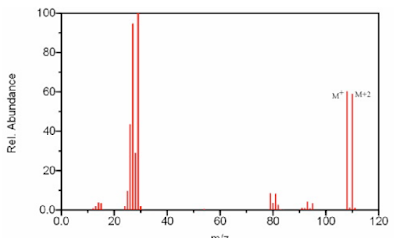Haloalkanes are organic compounds containing at least one halogen atom in their structure. Halogens are the Group 17 elements (specifically F, Cl, Br, and I).
In spectroscopy, we focus exclusively on chloroalkanes and bromoalkanes. This is because the iodine atom (in iodoalkanes) is so massive (a very large MR) that it makes the Mass Spectra difficult to fit on a page in an assessment, and it does not have stable isotopes to give characteristic spectra. I am not sure why fluoroalkanes are not assessed...
We primarily use IR Spectroscopy and Mass Spectrometry in conjunction to confirm if a compound is a haloalkane or not, and infer possible structure(s). We then use 13C-NMR Spectroscopy (number of carbon environments) in conjunction with Mass Spectrometry (fragment sizes) to confirm which structure is correct.
This section will focus exclusively on Mass Spectrometry, as we often use IR Spectroscopy to determine whether a halogen-containing compound is a haloalkane or an acid chloride. This will be covered in a separate section of the blog.
Mass Spectrometry
SOURCES:
- http://www.chem.ucalgary.ca/courses/350/Carey5th/Ch13/ch13-ms-2.html
- https://chem.libretexts.org/Bookshelves/Analytical_Chemistry/Supplemental_Modules_(Analytical_Chemistry)/Instrumental_Analysis/Mass_Spectrometry/Organic_Compounds_Containing_Halogen_Atoms
- https://www.whitman.edu/chemistry/edusolns_software/GC_LC_CE_MS_2017/CH%206%202017.pdf
Because both chlorine and bromine have common isotopes, these give characteristic peaks in their respective Mass Spectra.
The following table shows the relative abundance of some common isotopes, and shows why those of chlorine and bromine will appear as meaningful peak in Mass Spectra:
 |
| Source: Whitman (Source #3) |
The following Mass Spectra come from the same source as the table, and compare and contrast chloroalkanes and bromoalkanes with the same carbon chain:
 |
| Bromoethane |
 |
| Chloroethane |
When working with MR from the molecular ion in Mass Spectrometry, the best approach is to always use the lighter ion (i.e. M+) and the mass of the lighter isotope (i.e. for Cl use 35 not 35.5, or, for Br use 79 and not 80)
The following examples come from http://www.chem.ucalgary.ca/courses/350/Carey5th/Ch13/ch13-ms-2.html. They are good worked examples, explaining how we use Mass Spectrometry to explain the key fragments.
Note the isotope pattern at 122 and 124 represents the M+ and M+2 in a 1:1 ratio.
Note the characteristic isotope pattern at 78 (M+) and 80 (M+2) in a 3:1 ratio.
Loss of 35Cl from 78 or 37Cl from 80 gives the base peak a m/z = 43 (M - 35 = M+2 - 37 = 43) corresponding to the secondary propyl cation.
Note that the peaks at m/z = 63 and 65 represent fragment ions that still contain Cl and therefore also show the 3:1 isotope pattern.
The very small peak at 79 represents M+1, the small number of molecules that contain 35Cl and an atom of 13C rather than 12C.
The even smaller peak at 81 presents M+2+1 = M+3, a very small number of molecules that contain 37Cl and an atom of 13C rather than 12C.
The following examples come from http://www.chem.ucalgary.ca/courses/350/Carey5th/Ch13/ch13-ms-2.html. They are good worked examples, explaining how we use Mass Spectrometry to explain the key fragments.
Note the isotope pattern at 122 and 124 represents the M+ and M+2 in a 1:1 ratio.
Loss of 79Br from 122 or 81Br from 124 gives the base peak a m/z = 43, corresponding to the propyl cation.
Note that other peaks, such as those at m/z = 107 and 109 (yes, they are small) still contain Br and therefore still show the 1:1 isotope pattern.
Note that other peaks, such as those at m/z = 107 and 109 (yes, they are small) still contain Br and therefore still show the 1:1 isotope pattern.
Note the characteristic isotope pattern at 78 (M+) and 80 (M+2) in a 3:1 ratio.
Loss of 35Cl from 78 or 37Cl from 80 gives the base peak a m/z = 43 (M - 35 = M+2 - 37 = 43) corresponding to the secondary propyl cation.
Note that the peaks at m/z = 63 and 65 represent fragment ions that still contain Cl and therefore also show the 3:1 isotope pattern.
The very small peak at 79 represents M+1, the small number of molecules that contain 35Cl and an atom of 13C rather than 12C.
The even smaller peak at 81 presents M+2+1 = M+3, a very small number of molecules that contain 37Cl and an atom of 13C rather than 12C.


Comments
Post a Comment